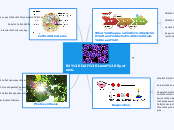Organs Image
Digestion Procedure
1. Ingestion - Taking food or another substance by swallowing or absorbing it 2. Digestion - Breaking food down mechanically into nutrients that is used for energy, growth, cell repair that are needed. 3. Absorption - Simple molecules that result from chemical digestion pass through cell membranes of the lining in the small intestine into the blood or lymph capillaries. 4. Assimilation - The process of absorbing nutrients during digestion and equally distributing it for growth and repair. 5. Egestion - This is the removal of undigested food that cannot be digested any further. It is removed from being solid or semi solid with the digestive tract and through the anus.
Hierarchy of Living Things
Cell
Cell Cycle
Plant Cell Image
Animal Cell Image
Plant Cells
Plant cells are the basic unit of life in organisms and Plant cells have special organelles called chloroplasts, which create sugars with photosynthesis.
Animal Cells
Animal Cell Parts
Nucleus
Ribosomes
Endoplasmic Reticulum
Golgi Apparatus
Lysosomes
Mitochondria
Cytoplasm
Cytoskeleton
Animal cells are enclosed by a plasma membrane and containing a membrane-bound nucleus and organelles.
Cell Divison
Cell division is the process by which a parent cell divides into two or more daughter cells
A cell cycle is a series of events that takes place in a cell as it grows and divides. ... The cell then leaves interphase, undergoes mitosis, and completes its division.
Tissue
A group of cells that have fanmilar functions with the same goal of helping the body
Connective Tissue
Support and protects the cells and tissues
Fat
Stores energy and is like a coat for organs
Red and White blood cells , Transports nutrients and oxygen , Takes care of bacteria and viruses
Bone
Movement and Support
Animal cells have different types of tissue
Cardiac Muscle
Contract as a unit
Smooth Muscle
Blood vessels and walls of organs contracts slowly
Skeletal Muscle
Movement is allowed and Cells line up in the same direction.
Nervous Tissue
Neurons send signals and receive them
Epithelial Tissue
Tissue Image
Columnar Epithelia
Columns of cells that line the organs.
Organs
Heart
Circulatory System
Circulatory System is made up from blood vessels that carry blood away and towards the heart. The circulatory system carries oxygen, nutrients, and hormones to cells, and removes carbon dioxide.
Circulatory System Image
Parts of the Circulatory System
Veins
Capillaries
Arteries
Blood Vessels
The Heart
Left and Right side
Blood
Respiratory System
The Respiratory System is responsible with all the organs to help us breathe oxygen in and removing carbon dioxide.
Gas Exchange
Exhalation
1. Diaphragm moves up 2. Rib cage goes in and down 3. Chest capacity decreases 4. Air rushes out
Inhalation
1. Diaphragm moves down as it contracts 2. Rib cage has in and out movements 3. Chest capacity increases 4. Air rushes in
The Circulatory System allows oxygen to be delivered into cells and takes out the carbon dioxide buildup.
Oxygen makes it's way in by getting inhaled and carbon dioxide gets diffused out with exhalation. Breathing in allows the lungs to expand and breathing out closes them down slowly and exchange occurs.
Respiratory System Image
Alveoli are surrounded with capitulary networks that contain blood.
Parts of the Respiratory System
Lungs
Bronchioles
Bronchi
Alveoli
Trachea
Larynx
Pharynx
Nose
Diaphram
Digestive System
Type of Digestion
Mechanical Digestion
Food is broken down by chewing, tearing, grinding of teeth and the stomach. It is a purely physical process controlled by you and it makes food smaller to have more area.
Chemical Digestion
Food is broken down with chemicals. enzymes break the chemical bonds that hold food particles together. This allows food to be broken down into small, digestible parts
The Digestive System breaks down food to release nutrient molecules that the body absorbs and uses.
Parts of the Digestive System
Digestive System Image
Stomach
Gallbladder
Pancreas
Anus
Large Intestine
Liver
Small Intestine
Esophagus
Mouth









